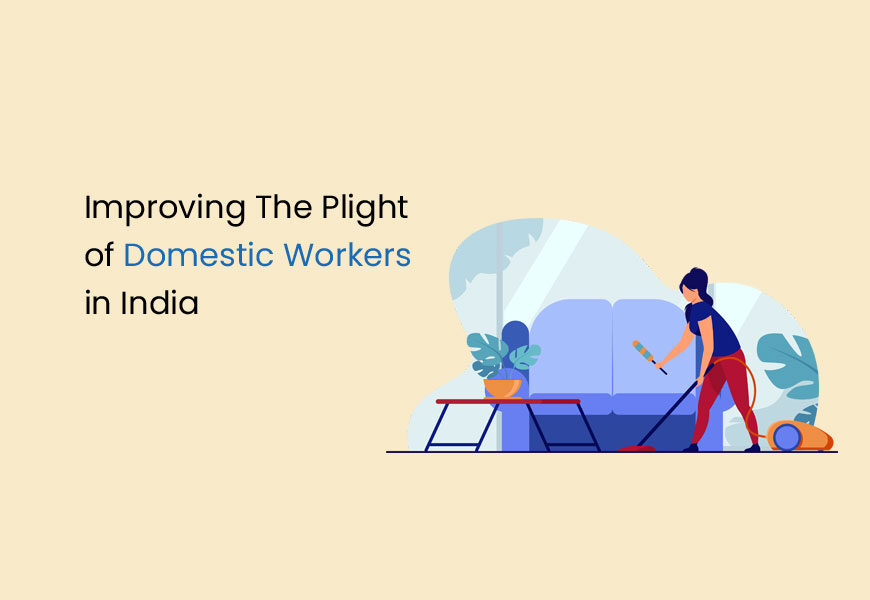Domestic workers are the backbone of most urban households and urban economies in India. Household and care work is stereotypically seen as women’s responsibility. Many middle-class and upper-middle-class women in urban India are able to engage in formal employment and earn a degree of success in their careers only because of the unseen assistance and support of their domestic workers. By extension, the households of these women are also able to live and function with lower levels of stress.
Domestic work offered by a whole army of domestic workers is an essential service for many urban households. Unlike in countries like the US and Denmark, paid domestic work isn’t a luxury or a good-to-have service.
Despite rendering such an essential service, domestic workers seldom have access to rights, protection or benefits. In fact, 94% of the world’s domestic workers lack social security according to ILO. Operating in the private and familial realms, the domestic workforce is rendered invisible. The multiple challenges and risks faced by this invisible workforce go unnoticed. Given the sector itself is highly unregulated, domestic workers are one of the most vulnerable sections of the population of India.
The Plight of Domestic Workers in India
Domestic workers are those who work and carry out duties within the confines of a private household(s) for remuneration. There are three key categories of domestic workers:
- full-time workers who work full-time for one employer but live out.
- part-time workers who may work in one or more households on an hourly/ part-time basis.
- live-in workers who work full-time with a single employer and stay in the premises of the employer.
Ever since liberalization in the 1990s, we have seen a massive rise in the number of domestic workers in India. In 1991, there were roughly 7.4 lakh domestic workers in the country. The number rose to 16.2 lakhs in 1999-2000, increasing more than 120% in the decade post-liberalization.
In the decade that followed the number rose another 150% to 25.3 lakhs in 2009-10. As per the latest NSSO (National Sample Survey Organisation) data from 2012, there are around 39 lakh domestic workers in India. And 26 lakhs of these workers are women.
We have already discussed in the introduction one of the key reasons for the growing demand for domestic workers. As the economy opened up and more women took up professions and paid employment, the need for domestic workers increased. The opening up of the economy also increased the disposable income of households who could outsource their household and care duties to domestic workers.
There are supply-side factors too for the increase in the number of domestic workers. There are both push and pull factors. The push factors include agricultural failure and lack of opportunities in the rural areas that push people to migrate to urban areas in search for better opportunities. Even among the urban poor, the lack of better opportunities often pushes them to take up domestic work.
The pull factors leading to the increase in domestic workforce are the increasing industrialization, urbanization and the lure of better-paying, non-seasonal work opportunities.
Here, we have highlighted some of the challenges faced by domestic workers in India.
Informal Work and The Lack of Benefits
Domestic work is informal in nature and workers, as a result, don’t have minimum wage regulations or even the basic rights, leave alone benefits.
Lack Of Social Security
Owing to poverty, domestic workers have high out-of-pocket expenses, especially for healthcare, that eat into their savings. Without savings, insurance, disability benefits, maternity benefits or pension, domestic workers have a high risk of falling further into poverty if a major expense, a natural disaster or a force majeure event like the Covid pandemic occurs. The lack of social security benefits leaves the growing population of domestic workers without any financial security.
Job Insecurity
Domestic workers enter employment without any contracts unlike formal jobs. So, they are hired and fired at will by employers who view them as highly replaceable entities. They don’t have any job security.
Poor Working Conditions
It is well-documented that domestic workers have poor working conditions owing to the unregulated, informal nature of work, lack of mobilization among workers and the sheer difficulty of monitoring. We keep seeing horror stories of poor treatment being meted out to domestic workers.
Domestic workers, especially live-in and full-time workers, don’t have defined work hours. They are not offered weekly or monthly days off and even when they do take off, they are faced with pay cuts. They lack rest and welfare facilities. They are at a high risk of violence and abuse – physical, verbal, emotional and sexual.
Policy Gaps
Without comprehensive policies, domestic workers are highly unprotected, vulnerable and exploited. There is a need for policies that ensure that domestic workers have access to minimum wage, decent work conditions, social protection and dignity of work, among others.
Gender-Specific Challenges
More than two-thirds of domestic workers in India are women and this gendering of work brings other challenges. Women domestic workers are often sole breadwinners or major contributors to the household income. The pay disparities are real as women domestic workers are paid even less than the already underpaid male domestic workers. Women domestic workers are at a higher risk of violence and abuse.
How To Improve the Plight of Domestic Workers in India?
While policy level changes and mindset changes are necessary, there is a small step that can be taken to instantly improve the lives of domestic workers.
By providing social security benefits…
Social security benefits provide a much-needed safety cushion to domestic workers in the event of any major expense, sickness, disability, natural disaster or involuntary loss of income. Healthcare benefits help ensure that they and their families get access to proper, timely treatment without any out-of-pocket expenses. They can save more and use their income for more critical expenses like children’s education, skill training and so on.
Domestic workers will have access to insurance, disability and pension benefits that will ensure that their family doesn’t fall into deeper poverty if anything were to hamper their earning ability. Retirement benefits ensure that domestic workers have some financial security and would not be forced to engage in heavy labour as they age.
Overall, providing social security benefits is a small, yet critical step in improving the plight of domestic workers. TankhaPay app was developed with this in mind. It enables employers to pay social security benefits to their domestic workers and other informal workers in a hassle-free manner.
Want to know more? Visit TankhaPay now.
Or
Download the TankhaPay app now














